by Trevor Boult
Unique to the coastline of Norway a remarkable daily ferry service operates year-round, the coastal express, Hurtigruten. Bergen is proud to be its southern terminus and far beyond the Arctic Circle, around North Cape and close to the Russian border, Kirkenes is its northern counterpart. Between these two extremities, a special family of ships provides the coastal population with a reliable highway of enviable record.
The centenary of the Hurtigruten occurred over twenty years ago. At that time, the elder statesman and symbol of the finest traditions of the service was Polarlys – Polar Light which had travelled the route for over forty years. At any one time half the fleet was northbound, the remainder heading south, a double crescent to link 35 ports with an ever-essential service.
Among the countless islands, fjords and parade of coastal mountains, each day on Polarlys was punctuated by pauses, often at tiny settlements such as Torvik, where 10 minutes was the allotted call, or substantial Trondheim, where the bliss of several hours allowed a breather in the precision of maintaining an exacting schedule. Keeping it, in all seasons, seemed a miraculous feat, a constant challenge to the workload of the two watchkeeping officers on duty at any one time.
At each ‘port’ local people boarded or disembarked, commuters bearing chattels, rucksacks, skis, paint tins, car tyres. Pets took comfort-stops, mail was collected, vehicles and staple products expertly handled from the hold. It was a colourful, ever-changing spectacle of real life, one that has long been sought by discerning travellers on what has also been called ‘the world’s most beautiful voyage.’
Easter 1992
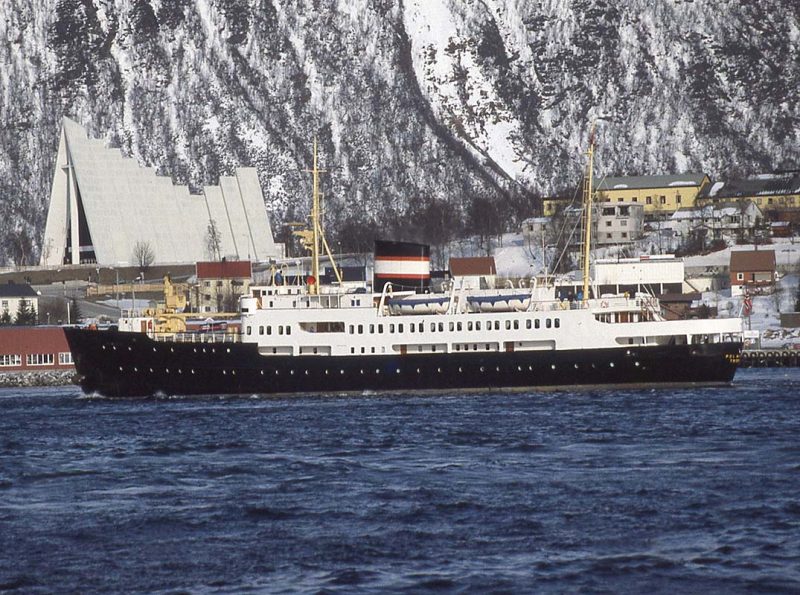
Faithful to a long tradition, on the dot of 10pm the gangway was dropped. The tri-chord whistle stirred the hearts of all those aboard, as the pulse of the ship quickened beneath the feet. The northbound Hurtigruten was leaving Bergen.
As ever on passenger vessels, heads appeared to silently supervise departure despite, or because of, the darkness and the damp, searching wind that blew onto the quay. These diligent witnesses to discomfort were rewarded by a rapid and complex manoeuvre, a pirouette that thwarted the element’s mischief with contempt. In the eleven days before Polarlys would berth again at Bergen, she would have touched at seventy quaysides, each one an individual challenge. By rudder, propeller, lines and anchor, magic was performed in tight arenas.
In the cabin, across the low porthole scudded mists of spume, lit by decklights from above. As luminous clouds of spindrift they were flung like a veil across the sporadic lights of shore, moving quickly around them. At Floro, in the harsh pre-dawn and the quiet of a ship still mostly in slumber, the purser donned heavy gloves and threw back the steel side-door, heaving the gangway into place in the face of stinging rain. Two travellers with rucksacks boarded. Even before the tickets were in their hands, the clanking anchor cable was hauling the ship off the berth.
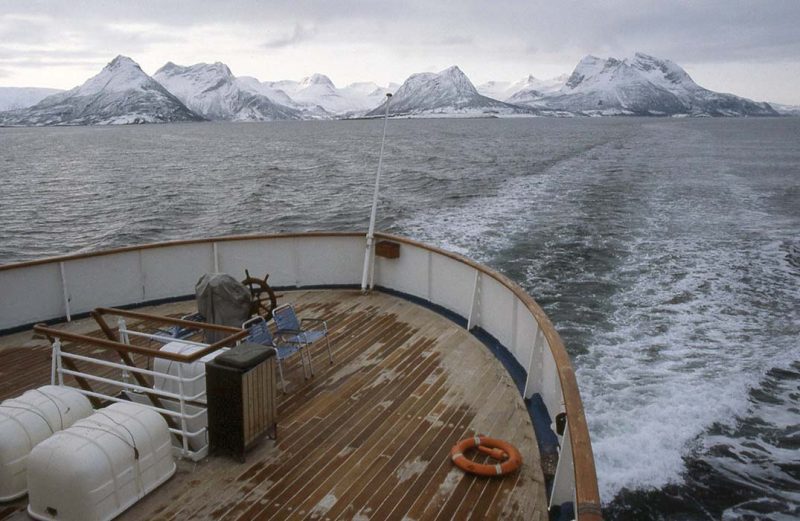
Our northward journey progressed, mainly in the grip of sheltered coastal splendours, yet with notable open-sea interludes. One such is Hustadvika, littered with isolated skerries awash, modestly marked with dancing buoys, a green spar loitering near the boundary of a seething turmoil, a cardinal beacon lurching and moaning a melancholy, deadly warning, making audible the movement of the waves as we passed close by. In the evening light, on the westward horizon, silent explosions of spray blossomed and burst on the teeth of reefs offshore.
In contrast, the convolutions and confines of the Stekksund passage brought passengers eagerly to the rails. Weather permitting, in the Lofoten Islands the ship is edged into the deep chasm of Trollfjord, to carefully turn and retreat from this wild and desolate cleft.
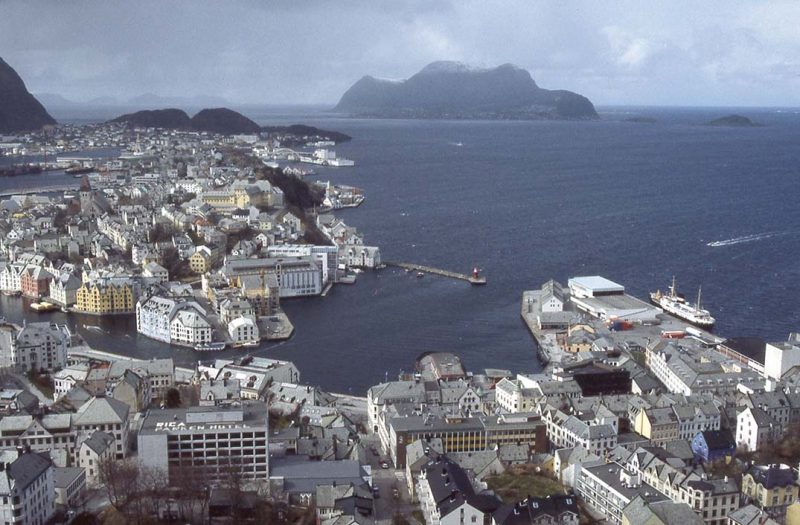

From the open decks of Polarlys, on coastal passage there could grow a heightened sense of isolation and unreality in the tiny settlements which even the Hurtigruten passes by. To walk from the vessel is to see and grasp at reality, to smile at seeing a petrol pump, or colourful flowers on a window ledge, to side-step the frantic forklift on the quay, or the hosing of hot water directed at the ship’s side windows.
There are times when conditions bring prudent defeat to keeping schedule and, with a gleam of heroic memory, the head-waiter spread a map on the cleared table. His finger traced past exploits of evading storms, hiding in the lee of the Lofotens, or riding it out offshore.
Weaving by islet or blinking multi-coloured beacon, or passing beneath high and delicately-arched bridges which interlink archipelagos, each day another ship of the service was met. As they surge past at close range, whistles blast in showmen’s greeting. So too, on approach to every daylight port, the strident announcement resounds.
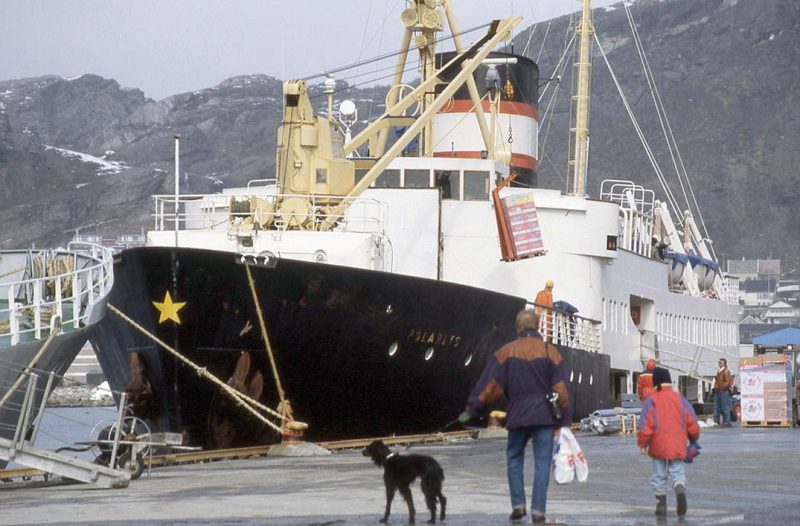
Early one morning the ship’s impressive voice spoke again, at the Arctic Circle. Polarlys has crossed the invisible but sought-after boundary countless times. Pacing the open boat-deck or the sheltered promenade, or sitting in comfort at those frequently-used windows, eager passengers had roused themselves, to pay homage to the Arctic, haunt of snow and mountain, slopes stark or populous with a colourless bristle-coat of trees, or vivid seasonal hues, the vibrance and surprise of life, of Norway and her Hurtigruten.

In the early 1990s the evocative sound of Polarlys’s whistle echoed with a lingering poignancy. Soon she was to give way to a new and much larger successor, and to find herself in Caribbean waters engaged in providing a very different kind of service, for the Mercy Ships organisation.
Mercy Ships is a global charity founded in 1978. It provides sea-going non-governmental support to developing nations and is firmly based on Christian values and principles. It delivers free health care, community development, agriculture and water projects, mental health programmes, AIDS/HIV prevention and care to terminally ill patients.
Polarlys was acquired by Mercy Ships in 1994 and renamed Caribbean Mercy. During her twelve years of service in this role she is recorded as having visited 18 countries and a total of 137 ports, conducting field service assignments in 56 port visits to 13 different developing nations, primarily in Central America and the Caribbean basin.
An average crew of 120 volunteers from more than 20 nations served onboard. Caribbean Mercy contributed more than 20% of Mercy Ships’ total output in terms of number of services, value and beneficiaries. During her conversion the ship was fitted with an eye surgery unit, cargo capacity and accommodation for up to 150 people while in port, as well as conference and seminar facilities. In 2006 the vessel was passed to the Sherman Family Charitable Foundation for renovation but was finally scrapped in 2010.
Polarlys, the second Hurtigruten vessel to bear that name, was one of several built in the 1950s to the same classic design. One of her sister-ships is Nordstjernen, the North Star. Norway is proud of its maritime heritage, recognising and celebrating the cultural stature of the Hurtigruten. At the time of her withdrawal from the coastal service in 2012, Nordstjernen was the oldest operational ship in the fleet and also held the longest ever history of Hurtigruten service.
In 2012 Nordstjernen was protected as a national heritage by the Norwegian government. Preserved as a working cultural icon, now independent of the Hurtigruten, she continues cruising on the Norwegian coasts and, as if in tribute to her sister, Polarlys, in the original Bergen Line colours.
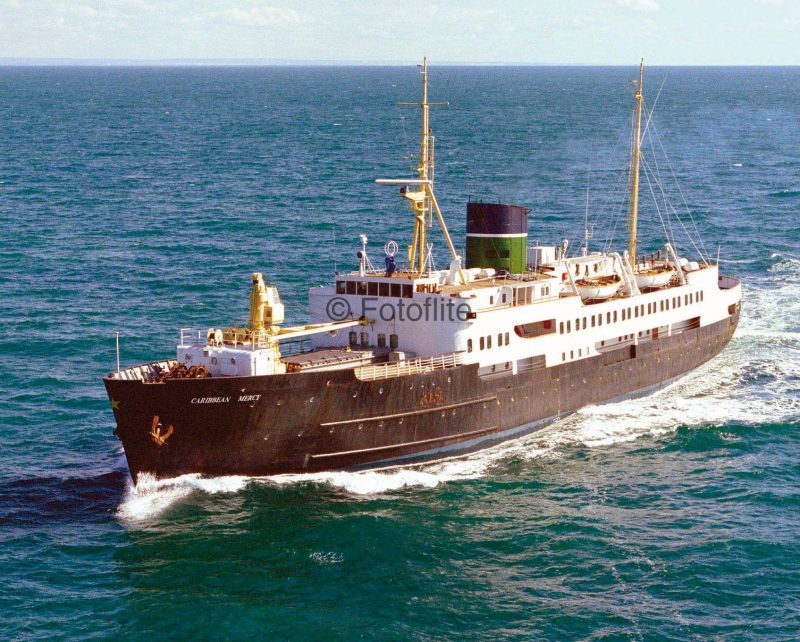


Comments
Sorry, comments are closed for this item